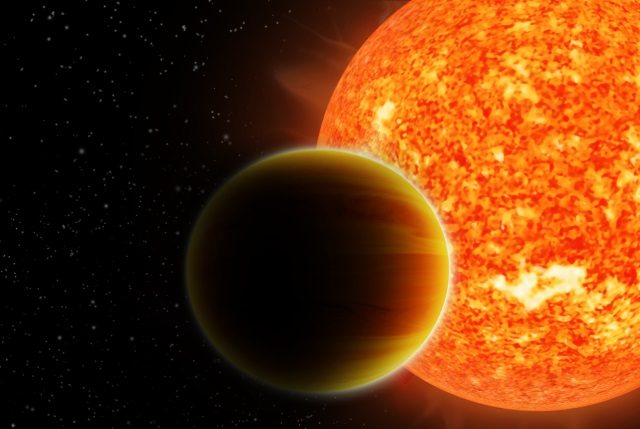
by Jiachen Jiang Tuesday, August 12, 2014

Illustration of a 'hot Jupiter' exoplanet orbiting its star. Credit: Haven Giguere, Nikku Madhusudhan.
Dust surrounding a star coalesces into larger particles, spinning and building over a million years or more to create the beginning of a planet. This is part of the widely accepted core-accretion theory of planet formation. As planetesimals combine into a planet, surrounding gases are attracted by the gravity of the new planet, forming the planet’s new atmosphere. According to the theory, oxygen, in the form of water vapor in the atmosphere, will be the most abundant element present on the planet. However, recent discoveries have raised questions about the commonly held understanding of the processes involved in planet formation.
In a recent study published in Astrophysical Journal Letters, a team of astronomers, headed by Nikku Madhusudhan of the University of Cambridge in England, found that the atmospheres of Jupiter-sized planets located outside of the solar system are much drier than predicted. Known as “hot Jupiters,” these exoplanets have temperatures ranging from 900 to 2,200 degrees Celsius and are considered the best candidates for measuring water vapor levels.
Madhusudhan and his team analyzed existing data of the near-infrared spectra of the atmospheres of the three hot Jupiters, based on information obtained from the Hubble Space Telescope. The three exoplanets orbit especially bright stars, which made it possible to measure their infrared spectra. Water molecules absorb certain wavelengths of light, dimming parts of the spectrum. With this knowledge, the team estimated the abundances of atmospheric water vapor on each of the three planets, which were 10 to 150 times less than expected.
Madhusudhan and his team considered the possibility that clouds and hazes composed of other, heavier particles were shrouding parts of the atmosphere and interfering with the water vapor signal, although they determined that the presence of such clouds was extremely unlikely. The team cited previous studies suggesting the implausibility of such heavy cloud particles being suspended higher than water vapor in the thinnest part of the exoplanets’ atmospheres.
Some astronomers, however, question the validity of the new study’s conclusions. “The case is not solid for any of these planets,” says Adam Burrows, an astrophysicist at Princeton University, who was not involved with the study but helped obtain some of the original data. The paper itself, he says, even concludes that two of the exoplanets examined could still have water abundances near those predicted. In addition, he says, the water abundance of one of the exoplanets examined, HD-209, which the authors claim is the most precise measurement, was only 20 to 135 times less than predicted. “When you start out with certain model assumptions — in particular, [that there are] no hazes — then you will get results that may be biased by these initial assumptions,” Burrows says. “Any bit of interference due to extra clouds and hazes is going to directly and qualitatively affect the conclusions here.”
Higher sensitivities are indeed needed to detect water on drier planets, Madhusudhan notes, but the study still casts doubts on the accuracy of measurements made of water abundances on exoplanets made by current instruments. Innovation and new developments in the field promise more accurate data that can be used in future studies, he says. NASA’s James Webb Space Telescope, for example, which is slated to launch in about four years, “will be able to take much better observations than the ones we currently have.” Analysis of these improved data, Madhusudhan says, may lead to new discoveries in the study of the physical and chemical processes of planet formation.
© 2008-2021. All rights reserved. Any copying, redistribution or retransmission of any of the contents of this service without the expressed written permission of the American Geosciences Institute is expressly prohibited. Click here for all copyright requests.